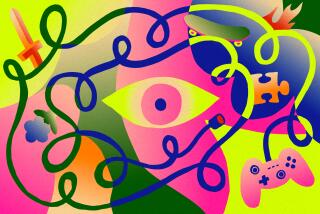How Radiohead helped make ‘Where Cards Fall’ one of Apple Arcade’s must-play games

“Where Cards Fall” originated at USC’s game school and has become a playable-for-all standout title on Apple Arcade.
Architecture is shuffled and folded to heighten a sense of fragility in “Where Cards Fall,” a puzzle game based on vignettes. The look is alternately realistic — we see glimpses of a home, a community and friendships — and abstract, where some moments are dreamscapes that explore life passions.
Each one of its challenges feels a bit like a song, since “Where Cards Fall” presents us with a character and a life and then leaves plenty open to interpretation. No puzzle should take more than a few minutes, and they’re stitched together with narrative bridges that give us glimpses into someone’s home and work over a lifetime. While it’s far from a visual album such as “Sayonara Wild Hearts,” a game that feels like an experimental music video, there’s something visually and playfully lyrical about “Where Cards Fall.”
It’s no surprise, then, that the game, available now for Apple Arcade, the tech company’s new $4.99-per-month subscription service, was inspired by song.
Apple’s iTunes recognized a weakness of the mainstream music industry. Now Apple Arcade is disrupting gaming. A preview of the games to play
In the mind of 28-year-old developer Sam Rosenthal for nearly a decade now, “Where Cards Fall” sprung initially from Radiohead’s 2007 single “House of Cards,” which sees the band shifting between lullaby-like guitar tones and disquieting digital symphonies. It served as an inspiration in more ways than one. Radiohead as a whole is adventurous yet accessible, music that takes risks while still being made for the masses — not unlike the sort of playable-to-all games that Rosenthal hopes to make — and the melancholic yet tender feel of the tune is similar to the tone that permeates “Where Cards Fall.”
Then there’s the core message of the song, of breaking something down only to create anew. Throughout “Where Cards Fall,” players assemble and disassemble buildings and platforms made of cards in an attempt to navigate life’s unexpected challenges.
“I always interpreted the song as kind of a plea from a man or a woman to leave their life behind — leave your marriage behind — and let their life collapse and rebuild something greater together,” Rosenthal says. “It’s a fairly dark theme, and I didn’t know too much — and I still don’t know too much — about married life. But at the very least, I thought there’s something beautiful in the idea of knocking down something that seems very structured and very safe and creating something greater out of it.”

“Where Cards Fall,” however, is less about domesticated, married life, and more simply about life as a whole. It’s framed around a character looking back and the choices made in getting from one point to another. The game’s animated sequences are never too direct — a lonely, solitary dinner at a diner, for instance, or an escape into the wonders of an arcade or the joys of music, the latter visualized with cloud-like platforms and guitars the size of skyscrapers. They give space for players to think about their own childhood and artistic discoveries.
Arriving at this point of view, however, wasn’t a direct path for Rosenthal, who studied undergraduate game design at USC. He initially began with a more literal approach, something that was influenced by games such as “The Sims.”
“I was pitching an actual house of cards,” he says, “with these little fragile lives unfolding inside of them. I thought that since cards were such a classic game piece, there might be some way of expressing that metaphor in a video game. But all of the ideas I tried were very complicated. I had individual cards that represented a person, a place or a profession and you’d put them together and you would see how the combination would lead to a family event or a life event.”
The game Rosenthal and his small team eventually developed at his downtown studio the Game Band, however, is rather simple.
Designed specifically for touch devices, Rosenthal uses game mechanics that should be familiar to anyone who has scrolled through photos on a phone and enlarged them or made them smaller. To build a card formation, you pinch two fingers together and then move them apart, utilizing the opposite move to break the same creation down. The card formations you create enable our character to traverse the landscapes, often mini-neighborhoods with a finely drawn comic style (think one influenced by Chris Ware). As the game progresses, the structures take on shapes of their own, making the puzzles slightly more complex.
After graduating from USC, Rosenthal worked at numerous game developers, including Toys for Bob on the “Skylanders” series and “What Remains of Edith Finch” for creators Giant Sparrow. But he continued to tinker on “Where Cards Fall” with the collaborators and connections he made while a student. While Rosenthal says prospective developers viewed the game favorably, the feedback he got was that premium mobile games — read those that are not free to play — were often dead on arrival.
Then Ryan Cash, co-founder of Snowman, the Toronto-based studio that released the exquisite snowboarding game “Alto’s Adventure,” came into the picture as the game’s publisher. The two had actually met via social media years before they had a working partnership, but Cash long kept his eye on the development of “Where Cards Fall.”
It was the personal and subtle nature of the game that attracted Cash, who speaks of taking numerous leaps of faith throughout his life, such as dropping out of school or quitting a job to build the reminder-based app Checkmark, which launched Snowman.
“I can really sympathize with the metaphor that Sam was going for,” Cash says. “Sometimes you have to take a risk and throw away everything that’s working and that you’re comfortable with and challenge yourself. It’s definitely not easy. It didn’t work out right away. We launched our first app and we didn’t have any plans beyond launching the first app.”
With “Where Cards Fall,” the hope is that Apple Arcade can create awareness and an audience around more thematically complex mobile games that lack any of the predatory mechanics that plague the free-to-play genre. Cash notes that “Where Cards Fall” is not a short game; it often takes 10 hours to see all of its puzzles, and likely would command a $19.99 price tag on its own if it were not part of Apple Arcade, a high figure that would essentially scare away most mobile consumers.
“If we really wanted to sell it as a paid game, and reach the most people, it would have to be 99 cents, but then that cheapens the product by saying, ‘This is only worth a buck.’ Then Apple Arcade came along and this is the perfect place for it,” Cash says. “People don’t have to spend $20 upfront to play this, and maybe they get drawn into Apple Arcade for ‘Sonic Racing’ and then see this and think it looks interesting.”
Annoying humans beware! An avenging goose is on the loose to right your anti-social wrongs.
And Rosenthal was stubborn on one point: The game had to stay a mobile release.
His ultimate goal is to share games with those who aren’t playing them, and he saw any game that would require the use of a controller as having a large learning curve for non-players, not to mention a greater barrier to entry in terms of cost.
“The reason I got into games is because I love them, but I was also frustrated that my friends and family don’t play,” says Rosenthal, the son of the accomplished baseball reporter for the Athletic and Fox Sports, Ken Rosenthal. “So I felt, OK, every one of them has an iPhone or iPad. If I can find a way to make beautiful, introspective experiences for these devices that they already have, then maybe we can broaden the audience.”
Cash’s goals are even grander.
“I see friends and family that are stuck in a groove. So if someone can play through this game and look at their own life and make a change for the better, that would be the greatest sense of accomplishment.”
More to Read
The biggest entertainment stories
Get our big stories about Hollywood, film, television, music, arts, culture and more right in your inbox as soon as they publish.
You may occasionally receive promotional content from the Los Angeles Times.











